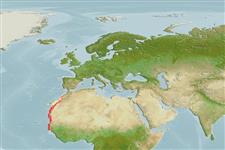>
Gadiformes (Cods) >
Merlucciidae (Merluccid hakes)
Etymology: Merluccius: Latin, mar, maris = the sea + Latin, lucius = pike (Ref. 45335).
Environment: milieu / climate zone / depth range / distribution range
Écologie
marin démersal; océanodrome (Ref. 51243); profondeur 15 - 1248 m (Ref. 58452), usually 100 - 600 m (Ref. 58452). Tropical; 33°N - 12°N, 19°W - 8°W (Ref. 58452)
Eastern Atlantic: western North Africa from Cape Cantin to Cape Roxo.
Length at first maturity / Taille / Poids / Âge
Maturity: Lm 40.9 range ? - ? cm
Max length : 81.0 cm TL mâle / non sexé; (Ref. 1371); common length : 42.0 cm TL mâle / non sexé; (Ref. 1371)
Épines dorsales (Total) : 1; Rayons mous dorsaux (Total) : 47 - 51. Head rather long. Pectoral fin tips usually reaching origin of anal fin. Caudal fin usually truncate, progressively becoming concave with growth. Color is steel gray to blackish on back, silvery white on sides and belly.
Feeds mainly on small fishes, and to a lesser extent on crustaceans and cephalopods. Undergoes seasonal latitudinal migrations (Ref. 9709). Spawning takes place in northern areas from January to March (Doutre, 1960), and from October to March (López Abellán and Ariz Telleía, 1993). Marketed fresh or frozen (Ref. 58452). Minimum depth reported from Ref. 26999.
Life cycle and mating behavior
Maturities | Reproduction | Spawnings | Egg(s) | Fecundities | Larves
Cohen, D.M., T. Inada, T. Iwamoto and N. Scialabba, 1990. FAO species catalogue. Vol. 10. Gadiform fishes of the world (Order Gadiformes). An annotated and illustrated catalogue of cods, hakes, grenadiers and other gadiform fishes known to date. FAO Fish. Synop. 125(10). Rome: FAO. 442 p. (Ref. 1371)
Statut dans la liste rouge de l'IUCN (Ref. 130435)
Menace pour l'homme
Harmless
Utilisations par l'homme
Pêcheries: hautement commercial
Outils
Articles particuliers
Télécharger en XML
Sources Internet
Estimates based on models
Preferred temperature (Ref.
123201): 10.2 - 16.8, mean 14.1 °C (based on 28 cells).
Phylogenetic diversity index (Ref.
82804): PD
50 = 0.5000 [Uniqueness, from 0.5 = low to 2.0 = high].
Bayesian length-weight: a=0.00501 (0.00308 - 0.00816), b=3.10 (2.95 - 3.25), in cm total length, based on LWR estimates for this species & Genus-body shape (Ref.
93245).
Niveau trophique (Ref.
69278): 4.5 ±0.80 se; based on food items.
Résilience (Ref.
120179): Faible, temps minimum de doublement de population : 4,5 à 14 années (K=0.07-0.17).
Fishing Vulnerability (Ref.
59153): High vulnerability (57 of 100).
Climate Vulnerability (Ref.
125649): High to very high vulnerability (75 of 100).
Nutrients (Ref.
124155): Calcium = 35 [17, 113] mg/100g; Iron = 0.674 [0.260, 1.661] mg/100g; Protein = 17.4 [16.2, 18.6] %; Omega3 = 0.102 [0.057, 0.183] g/100g; Selenium = 126 [54, 283] μg/100g; VitaminA = 26 [8, 86] μg/100g; Zinc = 0.568 [0.371, 0.874] mg/100g (wet weight);
